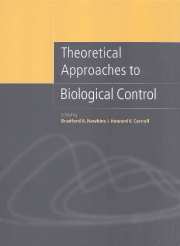Book contents
- Frontmatter
- Contents
- List of contributors
- Preface
- Part I Biological control theory: past and present
- Part II Ecological considerations
- Part III Spatial considerations
- 10 Dynamics of spatially structured spider mite populations
- 11 Habitat fragmentation and biological control
- 12 Outbreaks of insects: a dynamic approach
- Part IV Genetic/evolutionary considerations
- Part V Microbes and pathogens
- Index
11 - Habitat fragmentation and biological control
from Part III - Spatial considerations
Published online by Cambridge University Press: 13 August 2009
- Frontmatter
- Contents
- List of contributors
- Preface
- Part I Biological control theory: past and present
- Part II Ecological considerations
- Part III Spatial considerations
- 10 Dynamics of spatially structured spider mite populations
- 11 Habitat fragmentation and biological control
- 12 Outbreaks of insects: a dynamic approach
- Part IV Genetic/evolutionary considerations
- Part V Microbes and pathogens
- Index
Summary
Introduction
In the modern agricultural landscape, habitat destruction by agricultural activities is the most frequent cause of extinction in plants and animals. In addition to these deterministic causes of extinction, reductions in population size due to habitat fragmentation lead to further stochastic or random species losses (Shaffer, 1981; Saunders et al., 1991; Tscharntke, 1992a; Baur & Erhardt, 1995). Habitat destruction reduces the total area available for certain organisms, while habitat fragmentation generates a spatial pattern of more-or-less isolated habitats or populations. This disruption to habitat continuity is accompanied by significant changes in habitat characteristics and community dynamics.
Habitat fragmentation is usually only considered in the context of conservation, but is also closely related to the efficiency of biological control in the agricultural landscape. First, the spatio-temporal mosaic of natural habitats can be manipulated in such a way that populations of beneficials increase relative to pests. The propagation of natural enemy populations is part of a conservation strategy to increase biodiversity by increasing connectivity of natural habitats in the landscape (see Gliessman, 1990; van Hook, 1994; Fry, 1995; Van Driesche & Bellows, 1996). Second, annual crop fields are like defaunated islands, since they are usually cleared each year during harvest; that is, human destruction of established plant–insect communities necessitates annual recolonization of crop fields with corresponding annual rejuvenation of communities. Conservation management to enhance biological control can be viewed as an effort to neutralize the island-status of crop fields with a mosaic of old and closely interconnected habitat patches.
Information
- Type
- Chapter
- Information
- Theoretical Approaches to Biological Control , pp. 190 - 205Publisher: Cambridge University PressPrint publication year: 1999
Accessibility standard: Unknown
- 53
- Cited by
